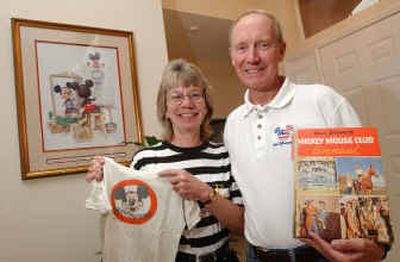These fans live their love of Disney

ORLANDO, Fla. – George Reiger has turned his tattooed body into a human animation cell for hundreds of Disney characters.
Betsy and Dale Nelson left their law enforcement jobs in Fort Lauderdale to move to an Orlando suburb so they would be closer to Walt Disney World; but the 45-minute commute wasn’t close enough, so they moved again – this time within 2 1/2 miles of the theme park.
Actor Patrick Labyorteaux of CBS’ “JAG” bought a second home just blocks from Sleeping Beauty’s castle in nearby Anaheim, Calif., so his family could drop in on Disneyland whenever they want.
These Disney fanatics have taken the theme park experience to the extreme. They’ve adopted it as a lifestyle – quitting jobs, transforming their bodies, purchasing real estate and moving to strange cities based on their need to immerse themselves in the innocence, happiness and community they feel the entertainment conglomerate gives them.
“The bottom line is it makes me happy,” said Reiger, 51, a postal worker and part-time magician in Bethlehem, Pa., who has been married six times. “Wives come and go, kids come and go, but Disney is always going to be there for me.”
Disney executives are very aware of the visceral, personal connection the theme parks have created for their fans.
“This is where the consumer experiences Disney at its best,” incoming Disney CEO Bob Iger said in a speech this year in Orlando.
Disney planted the seeds for this sort of mania by opening Disneyland a half-century ago, followed by Disney World and parks around the world in Paris, Tokyo, and later this year in Hong Kong. Disneyland begins celebrating its 50th anniversary next week.
Part of Disney’s success in creating hyper-fans stems from the “sacred” role the company has played in childhood and family life, said University of Oregon communications professor Janet Wasko. “As far as I know, Disney is the only brand that has so many fanatics.”
Reiger has found in Disney the happiness he never had in childhood. His parents divorced in Tampa when he was young, and his mother sent him to Pennsylvania to be with his grandmother. The adults in his life had two or three jobs, so the television – especially the Mousekeeters – became his baby sitter.
He got his first Disney character tattoo – Mickey Mouse from “The Sorcerer’s Apprentice” – on his first honeymoon in the early 1970s, around the time of Disney World’s opening. He has since covered his body in small tattoos and has gone on five more honeymoons – each time to Disney World.
“I’m reliving my childhood basically through Disney,” he said. “I’m making up for things I didn’t do as a kid.”
Like Reiger, Betsy Nelson, 56, became enamored with Disney as a 5-year-old watching “The Mickey Mouse Club” in the 1950s, and she regarded Mickey, Goofy and Minnie almost like friends. Her husband, Dale, acquired Betsy’s Disney devotion after they married in 1975.
They moved to the Orlando suburb of Lake Mary in 1999 but still found it too far from Walt Disney World. So they moved closer – 2 1/2 miles away.
In previous years, after getting off work for the weekend, they regularly drove to Disney World from Fort Lauderdale where Betsy worked as a prosecutor and Dale was chief investigator for the state attorney’s office.
“That was our escape from the job,” said Dale Nelson, 61. “In our professional lives, you didn’t see a lot of people walking around, smiling all the time and laughing. You go to Disney World … and you rarely see anybody not smiling or having a good time.”
Escapism is a major factor in Disney’s allure, especially in a post-9/11 world with heightened feelings of fear and insecurity.
“Many people … escape into this fantasy as part of a need to drop out of a world they neither fully understand nor want to participate in,” said Henry Giroux, a professor of communications at McMaster University in Ontario.
Even Labyorteaux, who spends his days portraying make-believe Lt. Bud Roberts on “JAG,” said there’s always a need to get away from it all.
“Like everyone in the world, our lives are very stressed out,” Labyorteaux said. “Why not enjoy a place that once you’re inside you have that happy feeling?”
But rather than simply being manipulated by Disney’s marketing machine, some of these hyper-fans go as far as to become a part of it.
Take Doris Lobring and her husband, Kirk. They left jobs in the construction business in St. Petersburg in the mid-1980s to work full time at Walt Disney World. The Cincinnati natives, then well into middle age, took jobs side-by-side, and steep pay cuts, dipping ice cream at Epcot for $5 to $6 an hour.
“We had to choose between money and enjoying life,” said Kirk Lobring.
They also decided to spend any extra money on Disney artifacts for filling what they called “The House that Mickey Built.” They purchased Disney clocks, telephones, knickknacks and drawings for every birthday or anniversary.
Doris Lobring died unexpectedly in April at age 70 of complications from pneumonia. Two hundred people, including workers dressed as Mickey Mouse and Minnie Mouse, showed up for a memorial service at Disney World where they remembered her infectious enthusiasm for all things Disney.
Hundreds of letters from visitors to the resort praising Doris were laid out on a table. Top Disney executives spoke about how she had inspired them with her spunk, and other workers talked about how they regarded Doris and Kirk as second parents.
“Doris had a passion for Disney,” said Kevin Digiammarino, her former manager at Disney World. “No matter what she did, it was about Disney.”